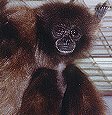 Meet Penny, one of IPPL's
Sanctuary Gibbons
Meet Penny, one of IPPL's
Sanctuary Gibbons
What a difference a few hours can make!
One crisp October morning in 1996 I boarded a plane in London, England, bound for Cameroon. I took along my first aid kit, a travelers' medical book, a few clothes, and 30 kilograms of much needed veterinary supplies provided by IPPL. Veterinarian John Lewis was in tow!
After weeks of preparation, I was anxious to put to work the knowledge I'd gained of primates through countless hours of self-study, working at IPPL's London office and volunteering at London Zoo.
By the end of the day I was in a totally different world, overwhelmed by the heat, the new people, the new job, and my new home.
Before I had even settled in, I learned just how "hands-on" my experience in Cameroon would be as I looked into the deep brown eyes of my new charge -- Benito, a five-month old infant gorilla. Six times during my first night in Cameroon my new "son" interrupted my much-needed sleep for feeding. Welcome to Limbe!
The Centre
After that first night of rather restless sleep, I was introduced to the Centre and the staff. Slowly I learned all about what the project was doing and how I could help.
Having never seen an African zoo, but having heard horror stories about them, I was very impressed with the standards kept at Limbe. The animals were well cared for and the enclosures built since Pandrillus' arrival were a tremendous improvement over the old cages.
All too often, project funds dipped to perilously low levels, with scant hope of new funds on the horizon. Soon after I arrived in Cameroon, Centre funds dipped critically low.
As happened many times during my time at Limbe, IPPL funds came to the rescue, enabling us to purchase food, pay staff and continue operations.
I become senior volunteer!
After Anna Randall's departure from the project in February 1997, I found myself suddenly in the senior volunteer position.
Goals were set amongst the volunteers and staff to improve enrichment as well as to maintain and enhance levels of animal care, and also to look at the place from a visitor's perspective.
We also decided to focus on our audience and efforts were undertaken to make the Centre more educational and aesthetically pleasing to Cameroonian visitors in hopes that they would both enjoy and learn from a visit to the Centre.
New paths and seating areas were constructed. Bushes and flowers were planted and educational signboards were designed and erected.
Positive changes
The appearance of the center changed dramatically during my time in Limbe. All this was due to the staff's hard work, donations from the Limbe Botanic Garden and a little creativity by the volunteers and keepers.
Judging from visitors' comments, especially those from people who had visited the zoo before, the improvements helped beautify the grounds, as well as enhance the Centre's conservation message.
The Staff
The Cameroonian staff are the true key to the success of the Centre. They serve as animal care-givers, educators, landscapers and construction workers.
Much of the work of the Centre is focused on changing attitudes of Cameroonians about their precious natural resources and that change in attitude is very apparent in the staff.
While many arrive merely looking for a job that will put food on their table, it is remarkable to watch how quickly they become attached to the animals and champion the cause of conservation.
The dedication, determination and commitment of the African staff is even more impressive considering many have grown up in a society that actively hunts and eats endangered species, including many of the primate and other animal species resident at the Centre.
The Animals
Of course, the animals are the whole raison d'être of the Centre.
The sights and sounds of the Centre will be indelibly etched in my mind, such as:
* a gorilla laughing, so distinctive, especially considering
their generally silent nature;
* the alarm calls of the young chimpanzees alerting us when
something was wrong or informing us it was time to eat;
* the lip smacking of the drills and mandrills as they groomed
my arm with their tiny yet forceful hands;
* the elegant beauty and the melodic trill of the Preuss'
guenon;
* the excited smile and jumping of the patas monkey;
* the grunts and pleading gestures of the baboons wanting
to be groomed.
It is tragic that these animals have been orphaned and are no longer in the wild with their families. It is fortunate, however, that there is a place for them to live in a happy, social environment - a place where they can live with others of their own kind and play a tremendous role in educating Cameroonians about their rich natural environment, and the importance of its conservation.
A Magic Moment
Just prior to leaving Cameroon I had an incredible experience. On the slopes of Mount Cameroon, in the forests north of the Centre, I observed chimpanzees in the wild. Watching a young chimp collecting fruit which he had shaken from a tree was perhaps one of the most magical moments of my time in Cameroon and, in fact, my life.
More than just an isolated experience, though, seeing chimps in their natural habitat provided a fitting end to my stay in Limbe.
While I enjoyed my time with the animals at the Centre, and I sincerely believe they live in a healthy, happy and social environment, I also know the Centre is not where chimps, gorillas, drills or any of those animals belong.
Their home is in the wild and the conservation education provided by
the Limbe Wildlife Centre is critical in helping ensure these animals will
survive in their natural habitat.
 Meet Penny, one of IPPL's
Sanctuary Gibbons
Meet Penny, one of IPPL's
Sanctuary Gibbons